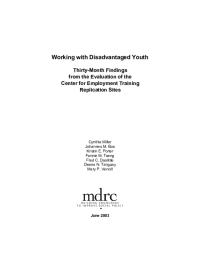Working with Disadvantaged Youth
Thirty-Month Findings from the Evaluation of the Center for Employment Training Replication Sites
Young people who lack postsecondary education or vocational credentials face an uphill battle in the competition for jobs. Two prior studies found that the services of the Center for Employment Training (CET) in San Jose, California, significantly increased low-income youths’ and single-mothers’ chances of finding employment and also raised their earnings. CET is noted for enrolling trainees with little prescreening, for providing training in a worklike setting, for requiring a full-time commitment from trainees, for involving employers in the design and delivery of training, for integrating instruction in basic skills into the training, and for allowing trainees to progress as they master competencies, without any fixed schedule.
In the early 1990s, the U.S. Department of Labor (DOL) provided funds for CET to provide technical assistance to other organizations interested in replicating the CET model, thus adding new programs beyond CET’s traditional base in San Jose and elsewhere in the western states. This study examines the experiences of youth in twelve CET sites outside San Jose: six in eastern states and the Midwest begun as part of the DOL-sponsored replication effort and six western programs operated as part of CET’s service network. This report summarizes the implementation findings and presents initial impact findings based on a random assignment research design and a survey conducted 30 months after application to CET.
Key Findings
The fidelity of program services to the original CET model varied greatly across the sites, affecting both implementation and impacts. Four study sites (all older, CET-operated programs) implemented the model with high fidelity; six sites operated programs with medium fidelity; and two sites implemented the model with low fidelity. Intensive participation in training and strong organizational stability were the two aspects of the CET model that were most difficult to achieve in the replication sites.
- In the high-fidelity sites, access to the program increased youths’ participation in training activities substantially above the level for the control group and increased the percentage of youths completing a training certificate. In the medium- and low-fidelity sites, impacts on service receipt and completion were smaller.
- In the high-fidelity sites, access to the program produced substantial positive impacts across a range of employment-related outcomes for young women, as reflected by the percentage of young women ever working, employment rates at the follow-up survey, and (quite probably) earnings — though the small sample prevents a statistically significant finding.
- For young men, the results in high-fidelity sites were either negative or negligible. The earnings of the program group were less than those of the control group — a result driven by declines in employment and hours worked, probably related to shifts in participants’ industry and occupation of employment.
- In the medium- and low-fidelity sites, impacts were either negative or negligible across a range of outcomes. Program group youth in the lower-fidelity sites had lower employment and earnings; impacts were especially disappointing for those without a high school credential and those who were teenagers when they entered the sample.
- Longer-term follow-up may produce more encouraging findings for men and for the low- and medium-fidelity sites. The strong economy during the follow-up period for this report allowed youth with low skills to find jobs, possibly lessening the impact of the CET program. The longer follow-up period now under way extends into the recent economic slowdown and provides an opportunity to see whether the enhanced skills produced by CET have positioned the program group members to better withstand a weaker job market.






